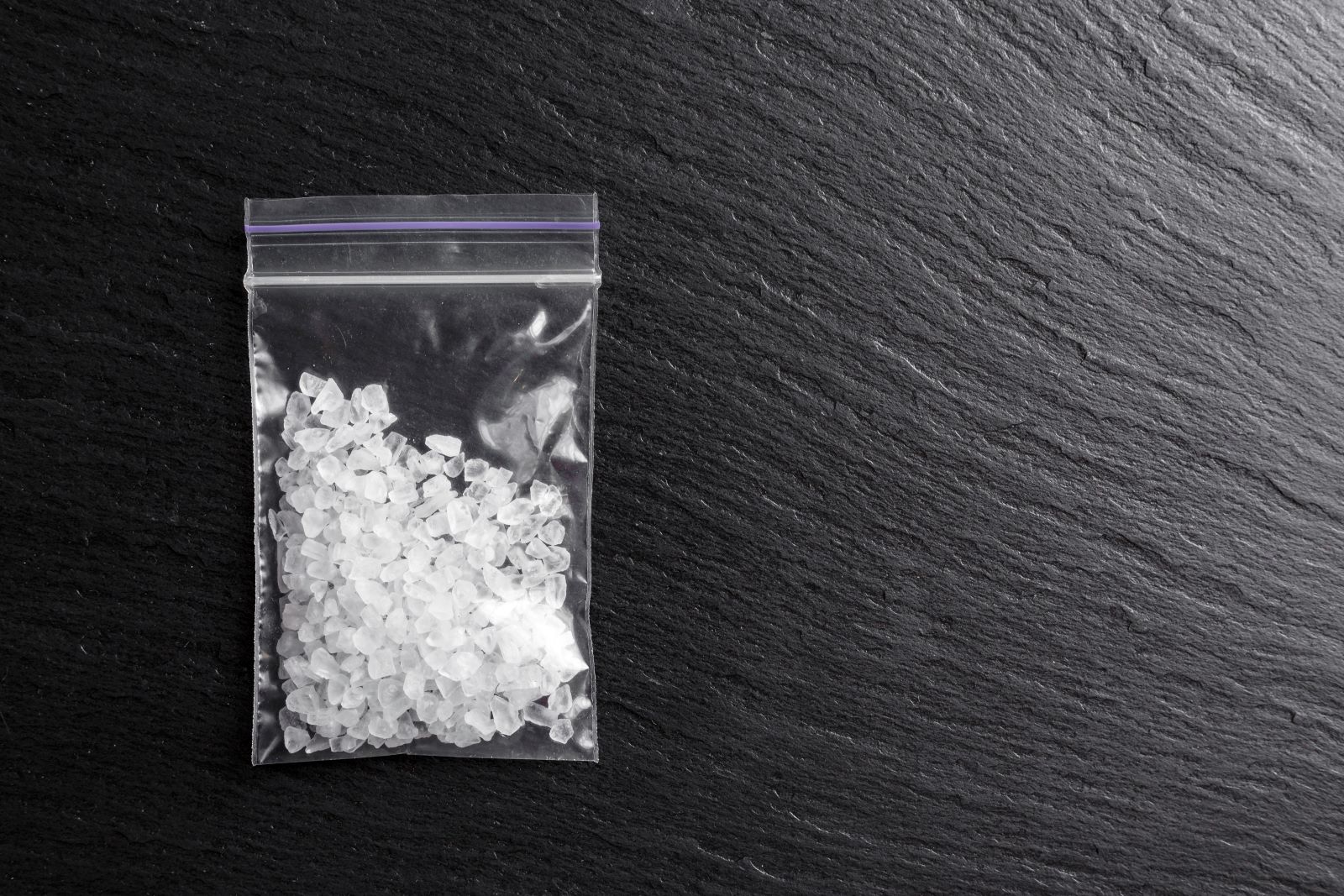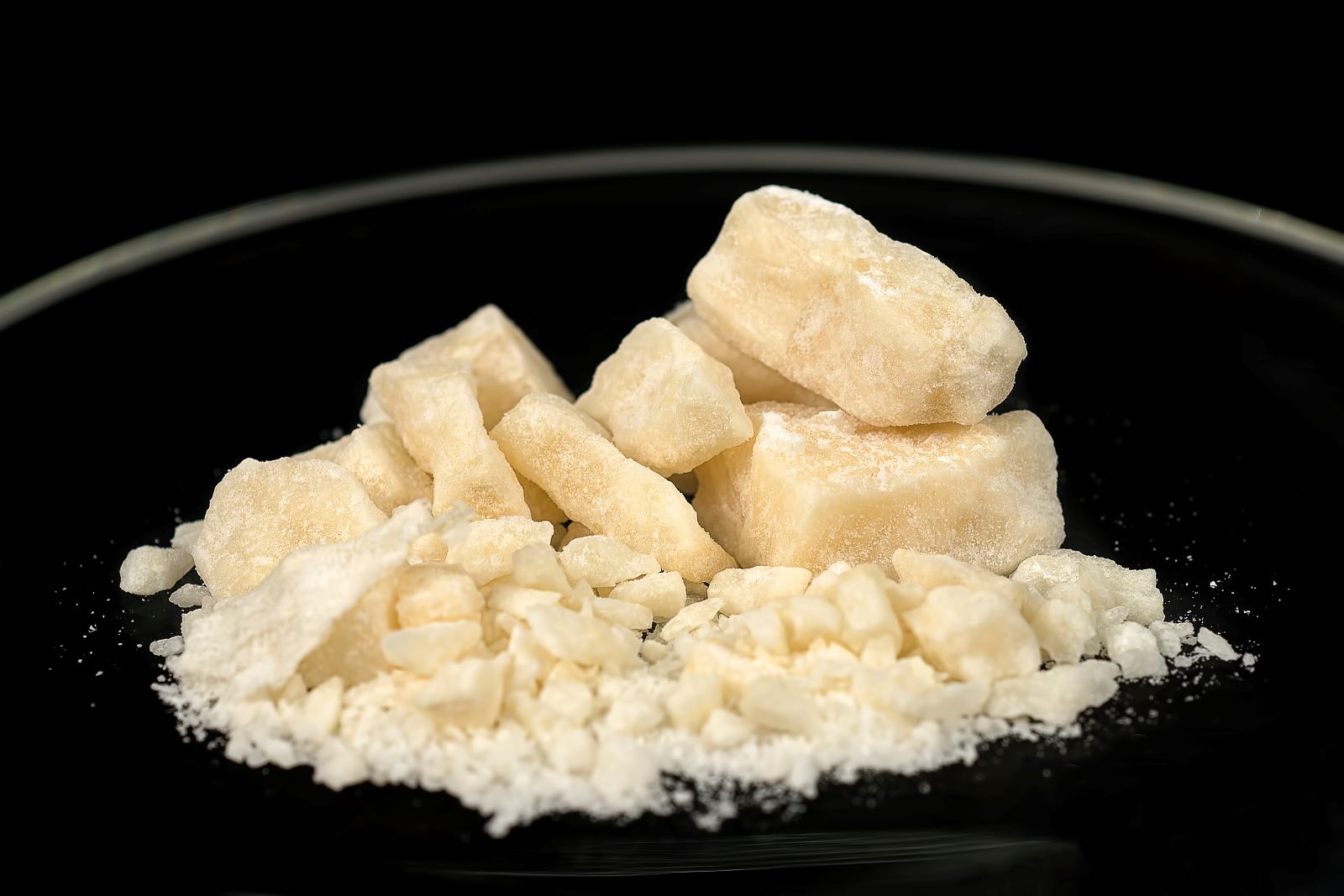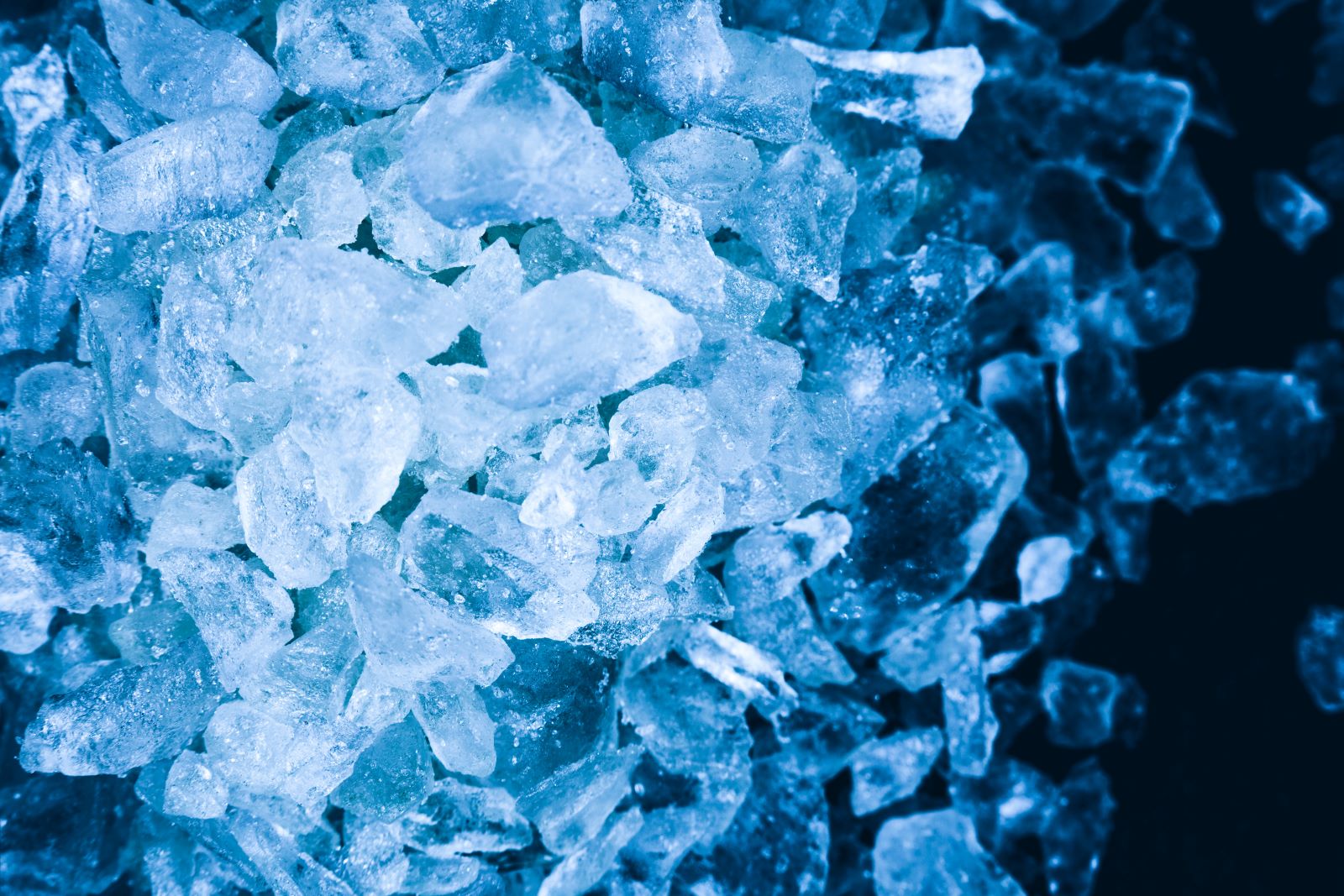Table of Contents
Crack cocaine and crystal meth are powerful, common drugs throughout the U.S. and across socioeconomic divides. Although these stimulant drugs have some similarities, they also possess distinct characteristics, leading to different substance abuse effects and origins.
Let’s go over the differences between crack vs crystal meth, shedding light on the intricate details that set these notorious stimulants apart.
Crack Drug Facts
The coca plant has grown in northern South America for centuries. People use the leaves for their stimulant and pain-relieving effects; the leaves are chewed and swallowed to attain the effects. Cocaine hydrochloride, the plant’s purified chemical, was isolated more than 100 years ago. [1] It led to the development of what most people know as powder cocaine and crack cocaine today.
Cocaine is classified as a Schedule II drug in the United States due to its addictive nature. However, it can be used for legitimate medical purposes by a trained doctor, such as local anesthesia for particular ear, eye, and throat surgeries.
Otherwise, it’s often diluted or cut by dealers to increase the volume sold without using the full amount of pure cocaine they may have. Substances used to cut cocaine include baking soda, cornstarch, and flour. But a dealer might use amphetamine or procaine, two other common drugs, to cut the batch.
In less than a minute of inhaling crack cocaine, you’ll begin to feel the extremely short-lived euphoric high associated with the drug. The rapid onset is due to the large surface area of your lungs being able to send the drug into your bloodstream and your brain’s mesolimbic dopamine system, or the reward pathway.[2]
Dopamine is a chemical messenger traveling between two neurons, a synapse, which tells your brain to feel pleasure. Normally, dopamine carries the message from one neuron to another and then is removed by a transporter, a specialized protein. The transporter then recycles the dopamine for additional use.
But, crack cocaine, and many drugs that are addictive stimulants, interfere with the transporter. It binds to the transporter and stops the dopamine from leaving the synapse, causing an accumulation of an augmented message to the receiving neuron. The message is now one of the increased pleasurable feelings.
In everyday settings or on the street, crack cocaine has many different names, such as:
- Candy
- Chemical
- Dice
- Fat bags,
- Gravel
- Hard ball
- Hard rock
- Jelly beans
- Nuggets
- Piece
- Product
- Rock(s)
- Snow coke
- Tornado
What Does Crack Look Like?
Crack looks like small pellets, rocks, or sometimes, soap shavings. It can have a rough texture or be smooth like porcelain, but overall is a hard solid. It’s produced when powder cocaine dissolves in water and baking soda. The mixture is warmed and boiled until a solid substance forms. The solid is removed and allowed to dry before the dealer breaks it into smaller pieces or rocks.
Crack cocaine rocks are normally white to off-white but can have a different color tint, such as yellow or brown. The color varies based on whatever the dealer cut the crack with during the manufacturing process.
How Is Crack Used?
Smoking crack is the only way to ingest this form.[3] How it’s smoked depends on the drug paraphernalia a person uses, such as a water pipe or a repurposed household item. However, the powder form of cocaine can also be smoked, a process called freebase.
Short-Term Effects of Crack Use
Although the high from crack occurs within seconds of ingesting, its side effects may take longer to develop and remain for a longer time. Common short-term effects of crack use include:
- Constricted blood vessels (notably in the brain and around the heart)
- Increased blood pressure, body temperature, and heart rate
- Dilated pupils.[4]
Long-Term Effects of Crack Use
Regular use of crack cocaine leads to many long-term effects of crack use, starting with your reward pathway in the brain, and losing sensitivity to natural, non-cocaine reinforcers.[5] As symptoms of withdrawal occur without higher doses, you or a loved one may begin to binge on the drug in an attempt to achieve previous highs. However, side effects after extended use include:
- Decreased mental health, including irritability, panic attacks, paranoia, and psychosis
- Higher blood pressure, which can lead to heart attack or stroke
- Rapid weight loss
- Respiratory distress, including pneumonia and lung infections
What Are Crack Withdrawal Symptoms?
If you or a loved one have a cocaine addiction, you’ll experience withdrawal symptoms shortly after ceasing use. These symptoms occur in two phases, acute and protracted.
Acute Withdrawal Symptoms
These symptoms happen immediately and include:
- Anxiety
- Difficulty concentrating
- Exhaustion
- Irritability
- Mood changes
- Unpleasant dreams
Protracted Withdrawal Symptoms
These symptoms happen weeks or sometimes months after last using crack and include:
- Agitation or shaking
- Anger or other emotional outbursts
- Cravings
- Depression
- Difficulty sleeping
- Inability to feel pleasure
- Lack of motivation
Identifying A Crack Overdose
The signs of a crack overdose appear more quickly than powder cocaine. If you or a loved one experience any of the following symptoms, contact 911 immediately:
- Clammy or sweaty skin
- Confusion
- Excessive itching or scratching
- Hyperactivity
- Increased irritability or violent behavior
- Going in and out of consciousness
- Noticeable decrease in respiration rate, or breathing
- Weak blood pressure or pulse
Make sure to tell the emergency responders that you or a loved one were using crack cocaine. This information helps the responders provide accurate and critical medical care before and during transport to a hospital.
Meth Drug Facts
Methamphetamine is an addictive stimulant chemically similar to amphetamine and is found throughout the United States. Nearly 2.6 million people 12 years and older in the U.S. used meth in the 12 months prior to 2020.
Its prevalence is due to international drug trafficking organizations and homemade labs and production operations. How meth is made depends on the chemicals available for production, such as pseudoephedrine.[6] These forms of meth are altered versions of Desoxyn®, a controlled prescription used to treat ADHD and obesity.[7]
Most meth found in the U.S. is manufactured in Mexico; this kind of meth is made with or without pseudoephedrine and in powder or liquid forms. It’s transformed into crystal meth or pill form by associate manufacturers in the U.S.
Because the production uses many accessible but hazardous chemicals, such as anhydrous ammonia, an agricultural fertilizer, it also has environmental impacts.[8]
Like crack cocaine, meth increases the amount of dopamine in your brain or your loved ones. While the effects of crack use primarily impact the respiratory system, meth affects the central and peripheral nervous systems. This results in higher instances of delusions, depression, psychosis, and violent behavior compared to crack.[9]
Common street names include:
- Black beauties
- Crank
- Crystal
- Glass
- Ice
- Poor man’s cocaine
- Speed
- Tina
- Tweak
- Uppers
- Yellow bam
What Does Meth Look Like?
The appearance of meth varies based on its form. Regular meth in pill or powder form is normally white and has a bitter taste. Crystal meth looks like glass fragments or shimmering bluish-white rocks and has no distinct smell.
How Is Meth Used?
Meth is used differently in its various form, such as swallowing a meth pill or smoking crystal meth. Some people snort powder meth, while others dissolve the powder form in alcohol or water and then inject it intravenously.[10]
Short-Term Effects of Meth Use
The effects of methamphetamine use are similar to amphetamines and cocaine, with short-term effects including:
- Increased blood pressure and body temperature
- Increased energy, physical activity, and wakefulness
- Irregular or rapid heartbeat
- Rapid breathing
- Suppressed appetite
Long-Term Effects of Meth Use
The long-term effects of meth use bring on many serious to life-threatening health problems including:
- Changes in brain function and structure
- Extreme weight loss
- Heart attack
- Intense itching and scratching, which can cause skin sores
- Serious dental problems, including tooth decay known as meth mouth
- Violent behavior could be related to experiencing hallucinations or paranoia
What Are Meth Withdrawal Symptoms?
Similar to crack cocaine withdrawal symptoms, someone with a meth addiction experiences the symptoms in two parts, acute and post-acute. The severity and duration of withdrawal symptoms depend on how the meth was used, use duration, intoxication level, and other factors.
Acute Meth Withdrawal Symptoms
- Anxiety
- Chills
- Cravings
- Dehydration
- Fatigue or lack of energy
- Inability to think clearly
- Low mood, including depression and suicidal ideation
- Withdrawing from others
Post-Acute Meth Withdrawal Symptoms
- Depression, including suicidal ideation
- Fatigue with excessive sleepiness
- Inability to experience pleasure
- Increased appetite
- Mood swings
- Psychosis
Identifying A Meth Overdose
Immediate medical treatment is necessary for a meth overdose as it’s a life-threatening condition.[11] The signs may vary from person-to-person but include:
- Agitation or aggressive behavior
- Breathing issues
- Chest pain
- Delusions or paranoid thoughts
- Increased body temperature
- Rapid heartbeat or palpitations
A meth overdose can also cause cardiac arrest; heart attack; hypertensive crisis; seizure; or stroke. If you or a loved one experience an overdose, call 911 immediately and let the dispatcher and emergency responders know you or your loved one have used or are using meth. This information allows them to make critical and accurate medical treatment decisions.
Breakdown of Crack Vs Meth
| Similarities | Differences |
|
|
|
|
|
|
The Dangers of Crack and Meth
The use of crack cocaine and crystal methamphetamine poses significant dangers that are both complex and far-reaching.
Physiologically, both substances exact a heavy toll on the body, causing cardiovascular strain and respiratory complications. However, the perils extend beyond the realm of physical health and can deeply impact mental well-being.
Users often struggle with heightened anxiety, paranoia, and a distorted sense of reality, leading to a mental health crisis. Socially, the consequences are equally devastating as relationships crumble, families break apart, and communities experience instability.
The enticing allure of these stimulants perpetuates a destructive cycle, where the pursuit of euphoria overrides responsibilities and disregards consequences. Recognizing and understanding these dangers is crucial for promoting informed prevention efforts and providing pathways for intervention and recovery.
Crack Vs Crystal Meth: What Treatment Looks Like
Breaking the cycle of crack cocaine use or meth addiction can be exceedingly difficult for yourself or a loved one without professional help and support. Several treatment options — intervention, detox, inpatient, and outpatient — are available, each providing an individualized course of care.
Detox Treatment
Detox treatment typically involves the careful supervision and medical support of doctors and nurses at a treatment facility. Detoxing is the cessation of substance use and immediately triggers withdrawal symptoms.
Residential or Inpatient Treatment Program
In a residential or inpatient treatment program, you or your loved one works one-on-one with a trained provider to seek out and mitigate the addiction. The program may also use group activities and support during this part of your or your loved one’s treatment.
Outpatient Treatment Program
Because addiction treatment is an everyday action, you or your loved one may receive continued support through an outpatient treatment program. Depending on your needs or theirs, outpatient treatment may include individual counseling and/or group support meetings peiodically.
FAQs Related To Crack Cocaine Vs Meth
What is the difference between addiction to crack and addiction to meth?
The effects of meth, such as an overwhelming euphoric feeling, last hours longer than crack (hours vs. minutes). However, meth has a higher instance of serious medical complications than crack because it’s derived from different manmade and synthetic chemicals.
How are these two drugs different?
Meth and crack differ in their origins — meth is manmade, while crack comes from the coca plant and its leaves.
What happens if you’re addicted to both crack and meth?
While both drugs are stimulants and create similar effects with their highs, an addiction to one or the other can cause the following health issues:
- Crack: Respiratory issues, respiratory tract ulcers, and chest pains.
- Meth: Dental issues, aggressive behavior, and twitching or seizures.
Overcome The Effects Of Crack Or Meth With Reliable and Effective Addiction Treatment At Infinite Recovery.
Crack cocaine and methamphetamine are used by millions of people each year, with many people developing addictions. Infinite Recovery helps people begin to regain a sense of life without addiction every day at our treatment center with comprehensive treatment programs, from rapid intervention to outpatient care. If you or a loved one have a substance use disorder, contact us today to begin your recovery.
Sources
[1] NIDA. 2022, May 2. What is cocaine? Retrieved from https://nida.nih.gov/publications/research-reports/cocaine/what-cocaine on 2023, January 6
[2] NIDA. 2020, June 11. How does cocaine produce its effects? Retrieved from https://nida.nih.gov/publications/research-reports/cocaine/how-does-cocaine-produce-its-effects on 2023, January 6
[3] National Drug Intelligence Center. (n.d.). Crack cocaine fast facts. Retrieved from https://www.justice.gov/archive/ndic/pubs3/3978/3978p.pdf on 2023, January 6
[4] NIDA. 2021, June 13. What are the short-term effects of cocaine use? Retrieved from https://nida.nih.gov/publications/research-reports/cocaine/what-are-short-term-effects-cocaine-use on 2023, January 6
[5] NIDA. 2021, July 9. What are the long-term effects of cocaine use? Retrieved from https://nida.nih.gov/publications/research-reports/cocaine/what-are-long-term-effects-cocaine-use on 2023, January 6
[6] DEA. 2022, October. Methamphetamine. Retrieved from https://admin.dea.gov/sites/default/files/2022-12/Methamphetamine%202022%20Drug%20Fact%20Sheet.pdf on 2023, January 6
[7] DEA. (n.d.) Methamphetamine. Retrieved from https://www.dea.gov/factsheets/methamphetamine on 2023, January 6
[8] NIDA. 2021, April 13. How is methamphetamine manufactured? Retrieved from https://nida.nih.gov/publications/research-reports/methamphetamine/how-methamphetamine-manufactured on 2023, January 6
[9] Prakash MD;Tangalakis K;Antonipillai J;Stojanovska L;Nurgali K;Apostolopoulos V. 2017, March 14. Methamphetamine: Effects on the brain, gut and immune system. Retrieved from https://pubmed.ncbi.nlm.nih.gov/28302577/ on 2023, January 6
[10] NIDA. 2022, December 19. Methamphetamine DrugFacts. Retrieved from https://nida.nih.gov/publications/drugfacts/methamphetamine on 2023, January 6
[11] Patterson, LPC, E. GoodRx. 2022, December 5. What Are the Signs of a Meth Overdose? Here’s When to Call 911. Retrieved from https://www.goodrx.com/methamphetamine/overdose on 2023, January 6



















